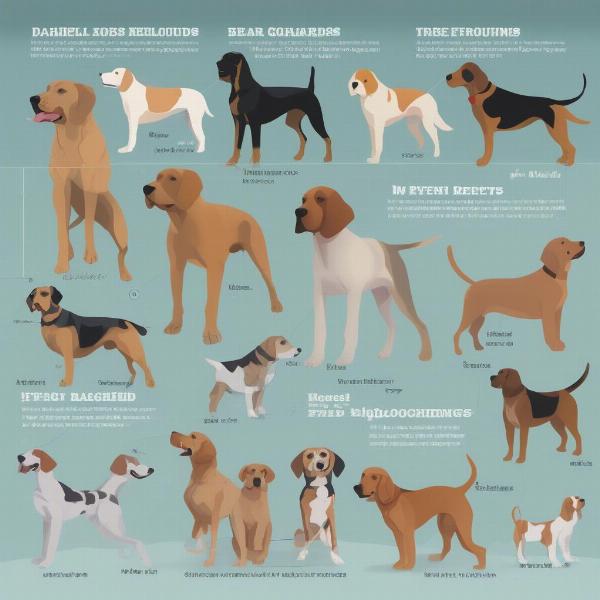Deer tracking is a specialized skill that requires patience, consistency, and the right dog. While some breeds are naturally predisposed to tracking, almost any dog with a good nose and a drive to hunt can be trained with the right approach. This article will guide you through the process of training your dog to track deer, from selecting the right puppy to advanced tracking techniques.
Selecting a Suitable Breed and Starting Early
Certain breeds excel at tracking due to their strong scenting abilities and prey drive. Popular choices include Bloodhounds, Beagles, Basset Hounds, and Drahthaars. However, don’t discount mixed breeds! Many mixed breeds possess the necessary instincts and can be trained effectively. The key is to start young. Early exposure to deer scent and tracking exercises sets a solid foundation for future development.  Choosing the right dog breed for deer tracking
Choosing the right dog breed for deer tracking
Introduction to Deer Scent
Begin by introducing your puppy to deer scent. Use a deer hide, antlers, or even deer bedding. Let your puppy investigate and become familiar with the unique aroma. Positive reinforcement is crucial at this stage. Reward your puppy with praise and treats when they show interest in the deer scent. This creates a positive association with the smell. Avoid overwhelming your puppy; short, positive sessions are more effective than long, tedious ones.
Basic Tracking Exercises
Start with short, simple tracks. Drag a deer hide or antler a short distance, creating a visible trail. Encourage your puppy to follow the scent. Use a tracking harness and leash to control their pace and prevent them from rushing ahead. Reward them when they successfully follow the trail to the end. As your puppy progresses, gradually increase the length and complexity of the tracks. Introduce turns, curves, and changes in terrain.
Advanced Tracking Techniques
Once your dog masters basic tracking, you can introduce more challenging exercises. These include tracking older trails, tracking across different terrains, and tracking in varying weather conditions. You can also incorporate distractions to test their focus and determination. Another advanced technique is blind tracking, where the handler follows the dog’s lead, relying solely on their tracking abilities. This requires a high level of trust and communication between the dog and handler.
Troubleshooting Common Issues
It’s common to encounter challenges during the training process. Some dogs may lose interest, get distracted easily, or become frustrated. Patience and consistency are key to overcoming these hurdles. If your dog is losing interest, try making the training sessions more engaging by using different scents or rewards. If they are easily distracted, practice in quieter environments before gradually introducing more distractions. Remember, each dog learns at its own pace, and there’s no one-size-fits-all approach.
Conclusion
Training a dog to track deer is a rewarding experience that requires dedication and patience. By starting early, using positive reinforcement, and gradually increasing the complexity of the training, you can help your dog develop the skills necessary to become a successful deer tracker. Remember to choose a breed that suits your needs and lifestyle, and always prioritize the well-being of your dog throughout the process.
FAQ
- How long does it take to train a dog to track deer? The time required varies depending on the dog’s breed, age, and natural abilities, but it typically takes several months to a year of consistent training.
- What is the best age to start training a dog to track deer? It’s ideal to start as early as possible, ideally when the puppy is a few months old.
- Can any dog breed be trained to track deer? While some breeds are naturally predisposed, almost any dog with a good nose and prey drive can be trained.
- What equipment do I need for deer tracking training? Essential equipment includes a tracking harness, a long leash, deer scent, and rewards.
- What are some common mistakes to avoid in deer tracking training? Common mistakes include rushing the process, being inconsistent, and using negative reinforcement.
Related Articles on ILM Dog
About ILM Dog
ILM Dog (https://ilmdog.com) is your trusted international resource for expert dog care advice. From breed selection and puppy care to senior dog health and advanced training techniques, we offer comprehensive guidance backed by experience and expertise. We cover a range of topics including dog breeds, health, training, nutrition, grooming, and product reviews. For personalized support and advice, contact us at [email protected] or +44 20-3965-8624.